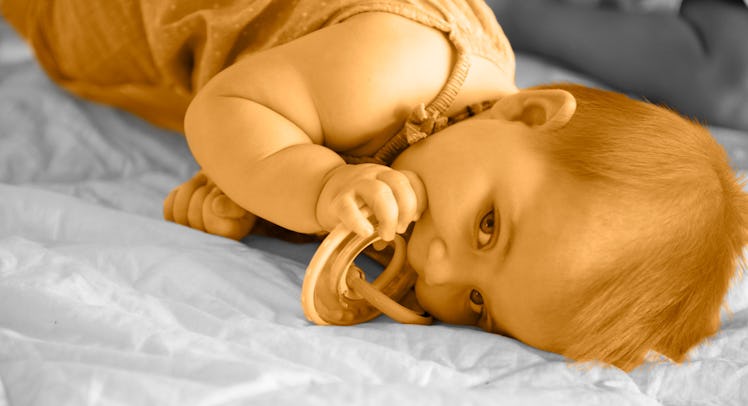How to Help a Baby Deal With Teething Symptoms
The pain and discomfort associated with teething is temporary, but with some patience and TLC parents can take the edge off.

Babies cut their first teeth at around 5 months, and it can be a painful experience for everyone involved. The incisors are usually first (lower before upper), followed by molars and canines. When those first teeth come in, you can expect a lot of drooling, crying, and changes in eating and sleeping behaviors. Once identified, there a handful of teething remedies parents can try.
Four Ways to Take the Edge Off a Baby’s Teething Symptoms
- Give them the finger. The simplest way to provide relief it to apply pressure with your fingers to the sore area.
- Freeze a ring. Teething rings are inexpensive and can seriously distract a baby from their discomfort… especially if there’s a big temperature change.
- Dampen a cloth. A clean, damp cloth provides an alternative sensation to plain old fingers—and it is very portable.
- Wait it out. The discomfort and sleepless nights are temporary, and all kids go through it. If the discomfort persists or the gum looks unhealthy, contact a dentist right away.
One of the clearest (and messiest) symptoms of teething is drool—and lots of it. “Obviously babies are not really accustomed to keeping social graces yet, such as keeping saliva in their mouths,” Dr. Jonathan Shenkin a professor and pediatric dentist at Boston University, told Fatherly. “But as anyone who has had pain in the mouth can tell you, you don’t necessarily want to close it. Kids drool, but they oftentimes drool more when teething.” Another telltale sign of teething is whitish bumps on the gum where the teeth are beginning to sprout. “The first thing you’ll see is a couple of bumps,” Shenkin adds. “They’ll become whiter as they erupt into the mouth.”
Parents should expect some changes in behavior around this time, Shenkin says, especially in terms of irritability. “Kids are going to be angry and fussy and crying, maybe more so than normal. Maybe they will wake up in the middle of the night crying.” If the baby is six months old and displaying these symptoms out of the blue, Shenkin says, then it’s probably tooth-related.
The first few teeth normally cause the most discomfort, and the teeth that follow the first incisors are often easier for a kid to deal with—but there are no guarantees. “There’s no rhyme or reason to what is going to cause the most discomfort,” Shenkin says. What does improve over time, however, is a parent’s reaction to teething symptoms. “Once parents get through the first set coming through, it becomes less traumatic because by then you understand the symptoms.”
Teething can also trigger a sudden loss of appetite. “The baby may have been evolving into a little feeding monster up until five months,” Shenkin says. “Then you’ll see this sudden and dramatic change in behavior.” This is almost always temporary, and not a cause for concern unless it becomes obvious that the baby isn’t getting what he or she needs in terms of nutrition.
Parents should confer with their pediatrician should they decide to use Tylenol or some other painkiller. But over-the-counter numbing gels are always a bad idea—The Food and Drug Administration recently pressured companies to remove these gels from shelves, due to potentially fatal side effects. Instead, try applying pressure to your baby’s gum with something as safe and simple as a (clean) finger or a damp cloth. Freezable teething rings are helpful too, Shenkin says, but it is best to avoid anything filled. “We don’t want to use a fluid-filled one that could break easily and go into the child’s body,” Shenkin says. Alternatively, Shenkin says, parents can offer a peeled and frozen banana. “It works like a charm, and it is full of potassium too!”
One noteworthy misconception is that teething issues can cause diarrhea, fever, and a cough. There is no evidence to back this up, Shenkin says and, if a baby shows signs of a fever at this time, then it is worth getting it checked out by a pediatrician.
The teething stage may seem overwhelming for a baby, but it’s worth noting that this phase is temporary. “Every child is going to go through this,” says Dr. Joseph Baytosh, who runs a family dental practice in Northeast Ohio. “It’s uncomfortable and it’s not fun.”
Baytosh adds that there is no panacea for parents to use to completely stop teething symptoms. “As parents, we look for quick solutions…but there’s no magic bullet that will take away the child’s pain or discomfort from teething,” Baytosh says. “Mostly it just calls for a lot of TLC”
This article was originally published on